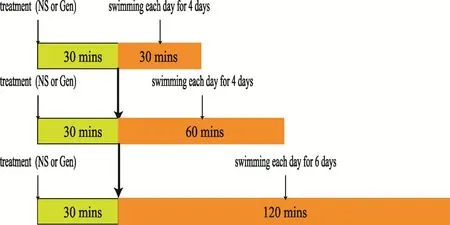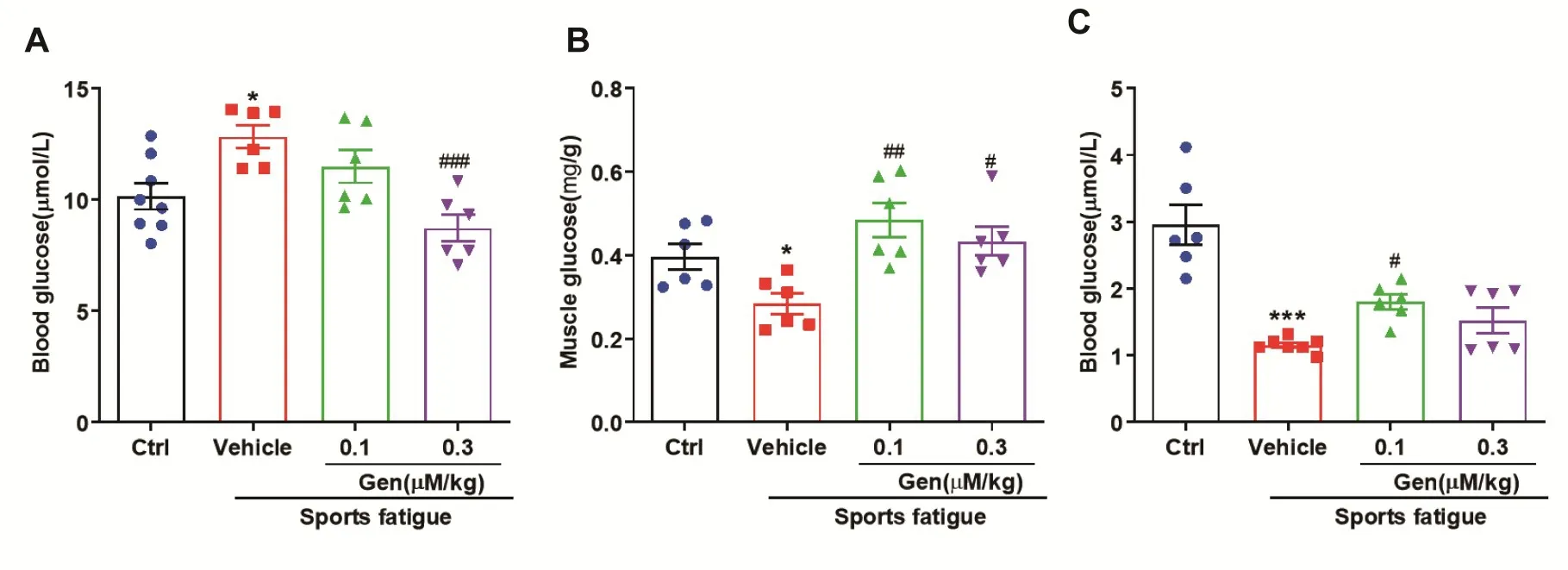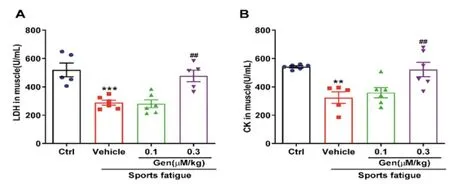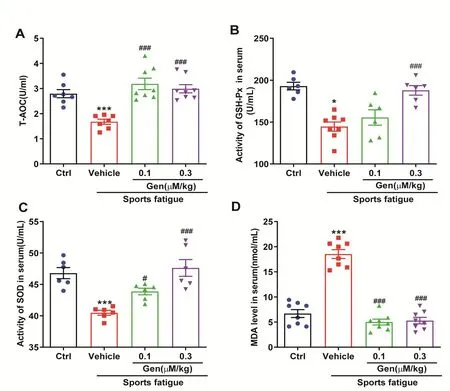麻 海 娟,曾 雪 亮,李 贝,黎 晓,吴 丽 珍,李 良 东,黄 诚,黄 志 华
(1.赣南医学院心脑血管疾病防治教育部重点实验室;2.赣南医学院疼痛医学研究所;3.赣南医学院第一附属医院,江西 赣州 341000)
Sports fatigue is a complicated phenomenon com⁃monly experienced by people in the modern cities[1].At the 5th international conference for biochemistry of exercise in Boston (1982),the sports fatigue was defined as a physiological process beyond which the body was unable to continue its exercise function at a specific level or was unable to maintain the predeter⁃mined exercise intensity[2].The causes of sports fatigue are elusive and complicated.Four theories can be sum⁃marized from literatures[3]:(1) Exhaustion theory,proposing that the large expenditure of energy sub⁃stances under intensive exercise like adenosine triphos⁃phate,blood glucose,and glycogen lead to the sports fatigue;(2)Clogging theory,stating that the accumu⁃lating metabolic productions under intensive exercise like lactic acid,ammonia is the cause of sports fatigue;(3)Ion theory,stating that sports fatigue is caused by the disorders of Ca2+,Mg2+,K+and some other ions under intensive exercise;(4)Radical theory,suggesting that the excessive free-radicals under intensive exercise damage the organelle‘s structure and function like cell membrane and mitochondria,and resulting in metabolic dysfunction and reducing ability to work,and finally leading to the sports fatigue.However,none of the theories can stand alone by themselves.To alleviate sports fatigue,in the point of modern medicine,the best solution is to prevent the emergence and accelerate the treatment process of sports fatigue when it occurs.Current research is aimed to find a safe,effective,non-toxic anti-fatigue agent with no side effects.
In the recent years,phytochemistry has proved to have a wide field of application.Interestingly,re⁃searchers also found that numerous anti-fatigue tradi⁃tional Chinese medicine are the phytooestrogens,such as Soy,kudzu and danshen etc.[4-5].Genistein(Gen),is an active ingredient of phytoestrogens extracted from soybean,sophora japonica,genistein or broad bean root,which has cardio-protective functions and is effec⁃tive in regulating energy metabolism and anti-oxida⁃tion[6-8].In the present study,it is hypothesized that Gen has protective effects on sports fatigue and it func⁃tions through the regulation of energy metabolism and anti-oxidation.
1 Materials and methods
1.1 Drug and reagentsGen was obtained from Shanghai Tian Xi Chemical Co., Ltd (Shanghai,People‘s Republic of China,Purity:99%),dissolved in Dimethyl Sulfoxide(DMSO),and diluted with the normal saline(NS).
1.2 AnimalsMale SD rats(180-220 g,specific pathogen-free grade,SPF) were purchased from the Hunan Slack Kingda Experimental Animal Company[Animal license:SCXK (Xiang) 2013-0004].The rats were housed in standard breeding cages at(22±2)℃,60%-70% humidity,in a 12 hour light/dark cycle (light-dark) for 7 days.They were given ad libitum access to water and food.All animal experimental procedures were approved by the Animal Use and Protection Committee of Gannan Medical University in China,which followed the guidelines of the International Association for the Study of Pain and according to the national Institute of Health Guide for the Care and Use of Laboratory Animals.
1.3 Sports fatigue animal model[9]Sports fatigue in rats was induced by swimming exercise(Figure 1).The swimming exercise was carried out in a water tank(120 cm×90 cm×60 cm) for 14 days.The tank contained water of 40 cm depth and the water temperature was maintained at 25 ℃.The rats underwent adaptive swimming training in the first 4 days,in which they were allowed to swim 30 minutes in the water tank once a day.In the next 4 days,it was the intensive swimming training.The rats had to swim 90 minutes once every day.Finally,they received the exhaustive swimming training,in which they swam,120 minutes once each day.When the rats were exhausted during the training,they were given a 5 minutes break before resuming the training.

Figure 1 Flow chart of sports fatigue model
1.4 Experimental groupsAfter adaptation for 7 days,32 rats were randomly and uniformly divided into control group (vehicle) and swimming groups(vehicle, 0.1 µmol·kg-1Gen and 0.3 µmol·kg-1Gen ).Rats in swimming groups were subjected to swimming exercise and treated with vehicle,0.1 µmol·kg-1Gen or 0.3 µmol·kg-1dose of Gen once a day by subcutaneous injection 30 minutes before swimming for 14 days.Rats in the control(Ctrl)group were not subjected to swimming exercise and were treated with vehicle only.
1.5 Measurement of biochemical parametersAfter the final swimming session,the rats were anesthetized with 0.35 mL·kg-1chloral hydrate.All the whole blood samples were collected from the abdominal aorta by using EDTA-Na2Pro-coagulation tube,and then they were centrifuged with the speed of 800×g for 10 minutes.The serum collected was kept in −80 ℃,which would be used for the measurement of the levels of total antioxidant capacity(T-AOC),superoxide dismutase(SOD),glutathione peroxidase(GSH-Px) , malondialdehyde (MDA) and blood glucose.All the blood biochemical parameters were measured by the commercial detection kits purchased from the Institute of Biological Engineering of Nanjing Jiancheng,Nanjing,China[10].
1.6 Measurement of Tissue Glycogen ContentsApart from blood collection,100 mg liver and quadriceps femoris muscle were dissected out.The tissues were washed with normal saline(NS)and then dried with filter papers.Afterwards, they were hydrolyzed by 300 µL potassium hydroxide in a boiling water bath for 20 minutes.The hydrolysate was saturated with sodium sulfate and then used for the detection of the level of lactate dehydrogenase(LDH)/creatine kinase(CK)in the quadriceps femoris muscle and glycogen using the Liver/Muscle glycogen assay kits (Institute of Biological Engineering of Nanjing Jiancheng,Nanjing,China)[10].
1.7 Measurement of tissue ATPaseLiver and quadriceps femoris muscle were dissected out.NS was added to the homogenate in 9∶1 ratio to dilute the homogenate 10 times.The activities of Na+-K+-ATPase and Ca2+-Mg2+-ATPase in the tissue were determined by the Minim ATP enzyme test kit(Institute of Biological Engineering of Nanjing Jiancheng, Nanjing,China)[11].BCA (Bicinchoninic Acid) method was used to quantify the protein content in the samples.The data of enzyme activities were normalized by protein content in the samples, which was the activities of ATP enzymes per mg of protein.
1.8 Statistical analysisAll statistical analyses were carried out using Graphad Prism 8.0.Data were presented as the mean ± SEM.Differences between groups were compared using one-way ANOVA followed by Newman-Keul‘s post-hoc tests.P<0.05 was considered to be statistically significant.
2 Results
2.1 Gen regulated glucose and glycogen metabolismThe alterations of blood glucose,muscle glycogen and hepatic glycogen were closely related with sports fatigue[12-14].After exercise training, the blood glucose level was significantly higher in the vehicle than that in the control group,while it was significantly lower in the 0.3 µmol·kg-1Gen group than that in the vehicle group(Figure 2A,P<0.001).In addition,both 0.1 µmol·kg-1and 0.3µmol·kg-1Gen groups showed significant improvement in muscle glycogen levels when compared with the vehicle group which was higher than that in the control group(Figure 2B,P<0.05).Regarding the hepatic glycogen level,it was significantly lower in the vehicle compared to that in the control group(P<0.001),while it was significantly higher in the 0.1 µmol·kg-1Gen group compared to that in the vehicle group.There was no significant difference in the hepatic glycogen level between the 0.3 µmol·kg-1Gen group and the vehicle group(Figure 2C).

Figure 2 Gen regulated glycometabolism(A)The content of blood glucose in serum.(B)The content of muscle glucose in serum.(C)The content of blood glucose in serum.The samples were collected after days 14 days swimming training.*P<0.05 and ***P<0.001 versus the ctrl group;#P<0.05,##P<0.01 and ###P<0.001 versus the vehicle group.All data were expressed as the mean ± SEM,n=5-8 each group.
2.2 Gen enhanced the activities of LDH and CK in muscleSkeletal muscle contains much LDH and CK.LDH and CK are the important enzymes in cellular energy metabolism.In incremental exhaustive exercise,the damage of skeletal muscle would occur after heavy intensity exercise,which enhanced the permeability of cell membrane and could cause the increasing of serum LDH and CK activity[15].In the present study,CK and LDH were also used to assess the effects of Gen on the quadriceps femoris muscle after the last exhaustive swimming exercise.The results showed that the muscle LDH levels in the 0.3 µmol·kg-1Gen group was significantly increased when compared with that in the vehicle group(Figure 3A,P<0.01).In addition,the muscle CK levels in the 0.3 µmol·kg-1Gen group was significantly higher than that in the vehicle group(Figure 3B,P<0.05).

Figure 3 Gen increased the activities of LDH and CK in muscle(A)The content of LDH in muscle.(B)The content of CK in muscle.The samples were collected from the quadriceps femoris muscle of rat after 14 days swimming training **P<0.01 and ***P<0.001 versus the ctrl group,##P<0.01 versus the vehicle group.All data were expressed as the mean ± SEM,n=5-8 each group.
2.3 Gen increased the activities of Na+-K+-ATPase and Ca2+-Mg2+-ATPase in liver and muscleWe found that Gen could improve the activity of ATPase,which could potentially alleviate fatigue.To investigate the underlying anti-fatigue mechanism of Gen,deter⁃mination was made about the activities of Na+-K+-ATPase and Ca2+-Mg2+-ATPase in both muscle and he⁃patic tissues.After the swimming exercise,the activities of Na+-K+-ATPase and Ca2+-Mg2+-ATPase decreased in muscle tissues,which was suggested by the comparison between the control group and vehicle group.The activities of Na+-K+-ATPase and Ca2+-Mg2+-ATPase in muscle were significantly improved in the 0.1 µmol·kg-1Gen group compared to those in the vehicle group(Figure 4A and Figure 4B).In the hepatic tissues the activity of Ca2+-Mg2+-ATPase and the Na+-K+-ATPase activity were decreased in the fatigue vehicle group compared to those in the control group.The Na+-K+-ATPase and Ca2+-Mg2+-ATPase activity was higher in the Gen group than that in the vehicle group(Figure 4C and Figure 4D).
2.4 Gen inhibited oxidative stress in the sports fatigue ratsIn normal condition, the dynamic balance between free radical production and antioxidant defense mechanisms in the body is maintained.However,the balance is disrupted during intensive and exhaustive sports.As the energy metabolism becomes extremely active, in which oxygen consumption in the skeletal muscle can shot up more than 100-fold,the production of reactive oxygen species (ROS) becomes beyond the limit of the antioxidant system to reduce ROS levels back to normal and this results in oxidative stress[16-17].In order to confirm the mechanism of Gen,after the last forced swimming session,blood samples were collected for the measurement of T-AOC,GSH-PX,SOD and MDA.The results showed that both 0.1 µmol·kg-1and 0.3 µmol·kg-1Gen groups had a remarkable increase in the T-AOC activity when compared with the vehicle group(Figure 5A,P<0.001).In addition,the GSH-PX and SOD activities in the 0.3 µmol·kg-1Gen group was significantly higher than that in the vehicle group(Figure 5B,P<0.01 and Figure 5C,P<0.001).Moreover,both 0.1 µmol·kg-1and 0.3 µmol·kg-1Gen group significantly reduced MDA levels when compared with those in the vehicle group(Figure 5D,P<0.001).

Figure 4 Gen increased the activities of Na+-K+-ATPase and Ca2+-Mg2+-ATPase in hepatic and muscle(A)The activity of Na+-K+-ATPase in muscle.(B)The activity of Ca2+-Mg2+-ATPase in muscle.(C)The activity of f Na+-K+-ATPase in hepatic.(D)The activity of Ca2+-Mg2+-ATPase in hepatic.(A-B)The samples were collected from the muscle of the rats after day 14 swimming training.(C-D)The samples were collected from the hepatic of the rats after day 14 swimming training.*P<0.05 and***P<0.001 versus the ctrl group;#P<0.05,##P<0.01 and ###P<0.001 versus the vehicle group.All data were expressed as the mean ± SEM,n=5-8 each group.

Figure 5 Gen attenuated the oxidative stress induced by sports fatigue(A)The content of T-AOC in serum.(B)The activity of GSH-Px in serum.(C)The activity of SOD in serum.(D)The level of MDA in serum.The samples were collected from the serum of the rats after day 14 swimming training.*P<0.01 and ***P<0.001 versus the ctrl group;##P<0.01 and ###P<0.001 versus the vehicle group.All data were expressed as the mean ± SEM,n=5-8 each group.
3 Discussion
Sports fatigue results in a depression of a person‘s physiological functions and exercise capacity.It is closely associated with factors such as the body‘s ener⁃gy consumption, metabolite production, oxidative stress damage,etc.[18].Energy depletion is one of the main causes of sports fatigue.In the energy cycle,adenosine triphosphate(ATP)is the primary energy resource,and sugar is used to produce ATP.Because the rate of ATP production is limited by the rate of glycogen breakdown,glycogen storage in the body can directly affect an individual‘s exercise performance[19].During long-term exercise,to support the high meta⁃bolic activities in the body,large amount of muscle glycogen (MG) is used to supply oxidative energy.During the intensive and exhaustive exercise,the rate of blood glucose consumption gradually increases,which leads to the decrease of blood glucose concentra⁃tion.The glycogen(LG)in the hepatic is then broken down into glucose to maintain the normal blood glucose levels in the body and brain[20].Abundant reserve of glycogen can also improve the sports ability and delay the fatigue during the intensive and exhaustive sports[21].As muscle and hepatic glycogen metabo⁃lisms play important roles in the energy production during exercise,glycogen is an important indicator to reflect the degree of fatigue in the body.In the present study,it was found that Gen increased the levels of muscle and hepatic glycogen,and meanwhile,it im⁃proved the consumption of blood glucose levels.It in⁃dicated that Gen could protect against sports fatigue by increasing the glycogen levels and improving the glucose utilization.
The accumulation of ROS in the body would lead to organ damage.Mitochondria is one of the main targets of ROS and it is also a main source of ROS[22].Mitochondrion is so-called "the plant of power" within a cell.By supporting oxidative phosphorylation with ATPase,it supplies the energy to that the cells in whole body.Therefore,the ATP enzyme plays impor⁃tant role in the body.For examples,the activity of ATP enzyme in muscle reflects the level of energy metabolism.The level of Ca2+-Mg2+-ATPase controls the contraction and relaxation of smooth muscle cells;and the activities of Na+-K+-ATPase directly influence the fatiguelevel[23-25].During strenuous exercise,lots of ATP is consumed.The activity of liver‘s ATPase would not significantly decrease.However,in muscle,the activities of Na+-K+-ATPase and Ca2+-Mg2+-ATPase would decline markedly,which could indicate the muscle metabolic abnormalities and the sports fa⁃tigue[26].The present study showed that the activities of Na+-K+-ATPase and Ca2+-Mg2+-ATPase of muscle of the sports fatigue rats significantly elevated after 2 weeks Gen treatment,suggesting that Gen plays a pro⁃tective role in regulating abnormal energy metabolism in muscle caused by strenuous exercise.In addition,it is important to note that the increase in ATPase by Gen in muscle would be beneficial for the maintenance of homeostasis,membrane structure,and energy me⁃tabolism,including the maintenance of contraction strength and muscle cell tension[27].
ROS attacks after strenuous exercise could lead to damage of the cells and the organelle structures of erythrocyte,myocardium and skeletal muscle.This encourages apoptosis and causes oxidative stress injury.Therefore,reducing oxidative stress caused by exces⁃sive exercise is one of the best strategies to alleviate sports fatigue.Our preliminary studies confirmed that Gen could increase the levels of red blood cell(RBC),white blood cell (WBC),blood platelet(PLT),lymphocyte(LYM),red blood cell volume(HCT),red blood cell distribution width(RDW)and mean corpuscular hemoglobin concentration(MCHC),which may suggest that Gen could also alleviate sports fatigue by regulating oxidative stress[28].Elimination of ROS mainly relies on the antioxidant enzyme system,which can be categorized into two main types:enzymat⁃ic reaction system and no-enzymatic reaction system.Antioxidant enzymes include,for examples,T-AOC,SOD and GSH-Px etc.T-AOC is the one that could re⁃flect the total antioxidant capacity of the body[29].GSH-Px and SOD are both the first-line defense antioxidant enzymes.GSH-Px is a kind of hydroperoxide lytic enzyme which widely exists in the body and its main function is to convert GSH into GSSG to reduce harmful peroxide by making it into harmless hydroxy com⁃pound.In addition,GSH-Px also promote the breaking down of H2O2.Therefore,it can protect the structures and functions of the cells from the damage by oxide[30].Another enzyme,SOD is an important natural antioxi⁃dant enzyme and its activity can indirectly reflect the ability of the body to eliminate oxygen free radicals[31].SOD can divide O2−disproportionation and generate H2O2to protect GSH-Px from O2−inactivation,while GSH-Px can protect SOD from being inactivated by H2O2.In general,every enzyme in the whole enzyme system interacts with each other to protect cells from the attack of ROS[32].In this study it was found that sports-fatigue rats had reduced levels of SOD,GSH-Px and T-AOC,but the levels of MDA which is a product of peroxidation significantly increased.Taken together,our data showed that free radicals would accumulate when sports fatigue takes place[33].
Accumulation of free radicals would oxidize the fatty acids in the membrane and damage the structure of membrane lipid and the structure of portion in cells.Moreover, it can overproduce lipid peroxides like MDA.All of these lead to the secondary damage in the body[34].Furthermore,lipid peroxidation damages the normal structure and function of mitochondrial mem⁃brane and causes the energy metabolism disorders,which results in the sports fatigue[35-36].Apart from these,lipid peroxidation can destroy the integrity of muscle cell membrane‘s structure and function,in⁃crease the cell membrane permeability,damage the function of the cells, and even lead to the cell death[37-38].When muscle cell membrane is damaged,membrane permeability increased and those muscle in⁃tracellular enzymes would outflow easily.Therefore,the levels of the enzyme in the muscle tissue such as lactic dehydrogenase(LDH),creatine kinase(CK)would significantly decrease[39].
LDH and CK are more abundant in the cells and only little could be found in the serum.LDH mainly exists in the muscle cells.In anaerobic glycolysis,it is the key enzyme of the reciprocal reaction to catalyze pyruvic acid into latic acid,suggesting that its level can directly influence the rate of anaerobic metabo⁃lism.CK is an enzyme widely existing in the cyto⁃plasm and mitochondria and it is also one of the main enzymes that can catalyze the production of creatine and ATP.Because CK could regulate the stability of ATP concentration,it plays an important role in the energy metabolism[40-42].When zymoprotein is dam⁃aged by oxidative stress,the stability of its activity would be reduced and the transcription accuracy of zymoprotein would be affected.When CK activity de⁃creases,the energy supply to the cells would be affected and cells would be damaged eventually[43].
In our study,compared to the vehicle group,the rats treated with Gen showed beneficial changes in the the serum antioxidant enzyme system.The levels of SOD,GSH-Px and T-AOC significantly increased,while the activity of MDA was obviously decreased.In addition,the activities of LDH and CK in muscle also increased remarkably.The data suggests that Gen is beneficial to maintain the balance between the free radicals and antioxidant defense system,reduce the accumulation of free radicals,which helps reduce the damage of the skeletal muscle cell and prevent the leakage of enzymes[17,44].In addition,it was found that the levels of muscle‘s LDH in the rats treated with Gen significantly increased,which can promote the break⁃down the skeletal muscle lactate and reduce the accu⁃mulation of lactic acid.Furthermore, the study showed that CK activity increased in the muscle after Gen treatment,which could be beneficial to the intra⁃cellular energy running,muscle contraction and the production of ATP[45].The present study suggested that Gen could improve the sports endurance and delay the emergence of fatigue.
4 Conclusion
In summary,the present study showed that Gen could alleviate sports fatigue by regulating energy me⁃tabolism and maintaining the balance between free radicals and the antioxidant system,which suggests that Gen may serve as potential candidate for sports fatigue.



